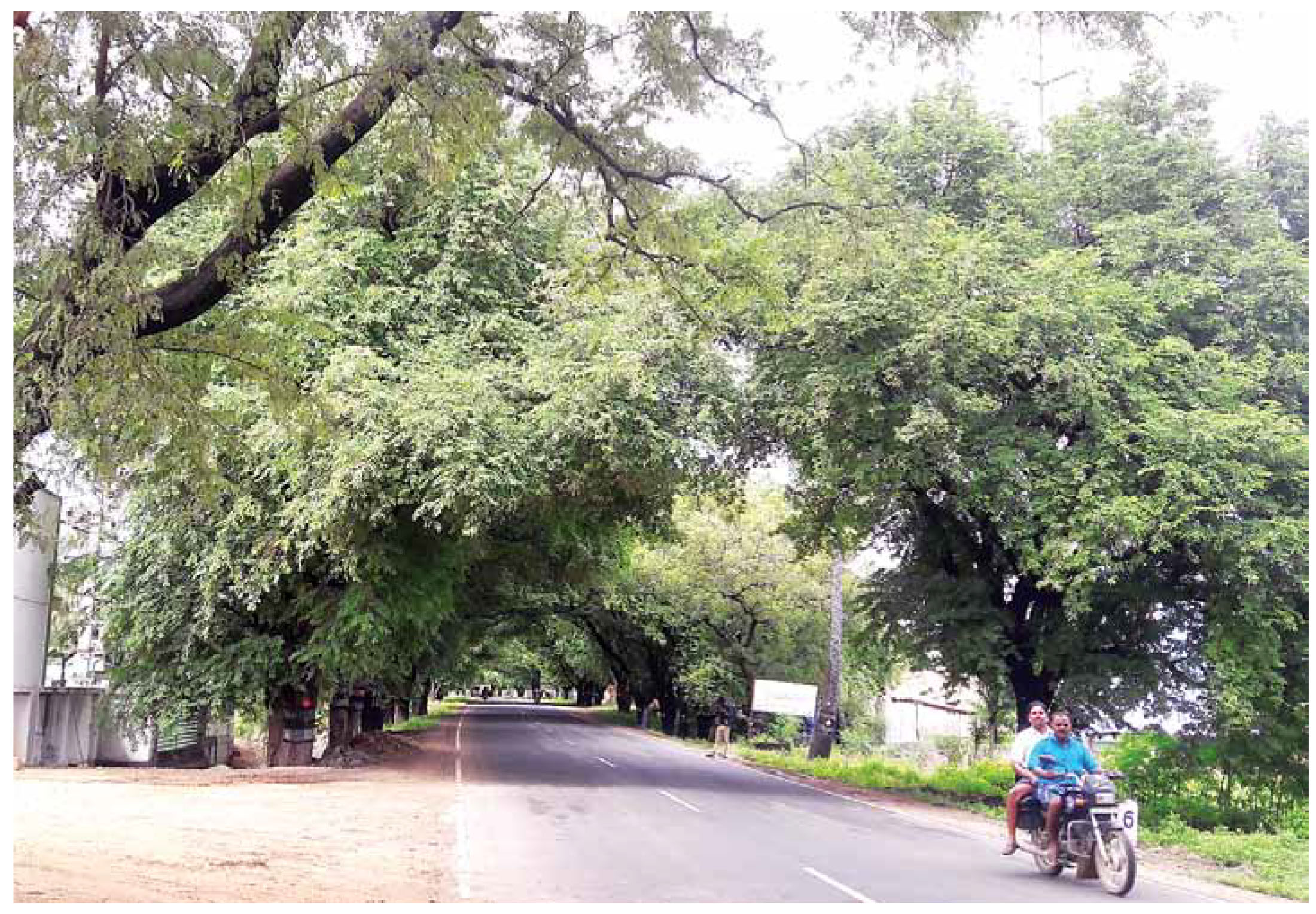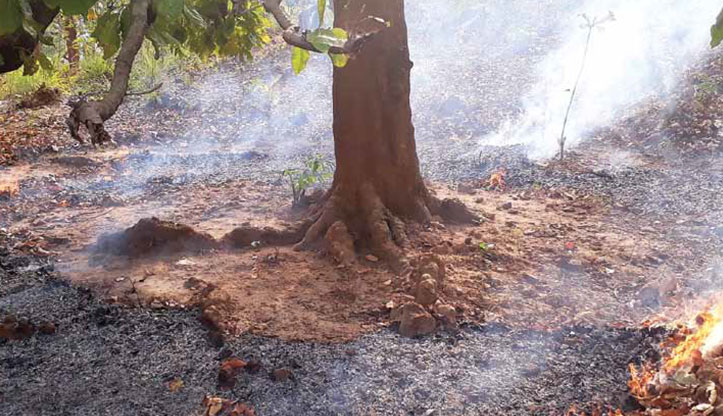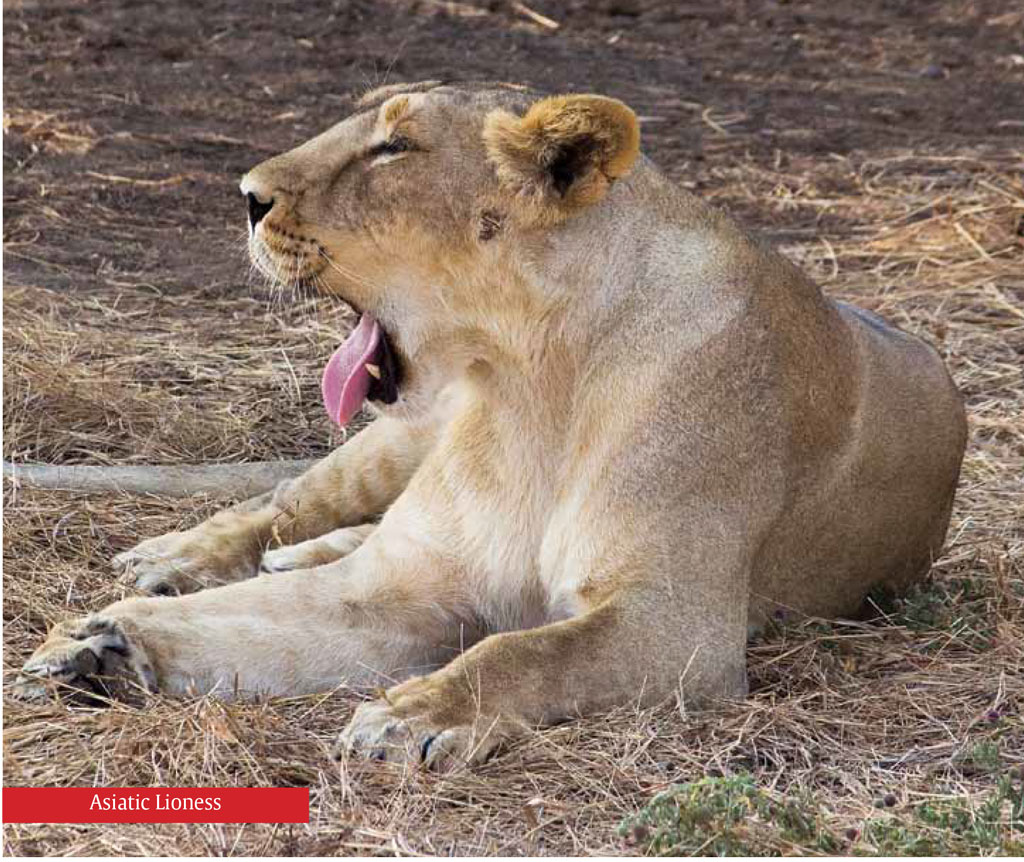
Fig. 1. Beauty of the landscape of the roadsides due to tamarind trees.
Impact of removing the bark of trees for numbering on the health & longevity of Trees
By R. Sundararaj and R. Raja Rishi
Abstract: Surveys were undertaken to understand the impact of the present method of numbering the roadside trees on their health and longevity. The study revealed that wounding of trees for numbering has an adverse effect on the health and longevity of the trees. Hence, it is recommended to avoid the present method of numbering trees by removing the bark and to find an alternative method of numbering without causing any injuries to trees.
Keywords: Roadside trees, tree decay, numbering of trees
INTRODUCTION
Woody perennial trees are well known for providing several tangible and intangible benefits, such as sources of timber, fire-wood, fruits, shade, shelter and habitat for other living forms and oxygen. They assimilate atmospheric CO2 and thus play an active role in mitigating climate change, and stabilizings oil and controlling erosion, thereby providing immense ecological services.
The trunk of a tree is composed of the outer sapwood essentially involved in conduction of sap, and the inner core of heartwood giving mechanical strength to the tree. The outermost thick covering of the sapwood is the bark, which is one of the most important parts, primarily protects the tree from all forms of injuries and entry of degrading agents.
Wood decay in living trees is a major concern, causing loss of wood products and product quality and it damages wood in service and creates hazards for people and property. (Short leand Dudzik, 2012).
Tree decay is an important cause of tree hazard so that it creates major mechanical defects in the tree form which most likely lead to increased physical failures of either the whole tree or its branches. While many biotic and abiotic factors are involved in the decay processes, the primary factor responsible for decay is the wounds or injuries which make the trees susceptible to bio-deteriorating organisms (Mohan et al., 2022).
The numbering of roadside trees and valuable trees like sandalwood in forests is a mandated practice across the country to provide the details and number of trees present on a particular stretch of road or in the forest. This enumeration of trees also facilitates the auctioning of any fruit yielding trees (like Tamarind) for revenue generation, easy identification of theft cut if any and also to tender for auctioning to remove/clearing a particular tree if it falls due to any natural calamity.
The trees are numbered by removing a half square foot area of bark at the chest height of the tree, painting the exposed sapwood and numbering the spots. This paper analysis the impact of such a method of numbering and finding is presented in this communication.
MATERIALS AND METHODS
Extensive survey were conducted in southern states viz., Andhra Pradesh, Karnataka and Tamil Nadu on the roadside trees and sandalwood in Marayoor sandalwood reserve in Kerala. The districts surveyed in Karnataka are Chikballapur, Kolar, Mandya, Mysore and Tumkur. The districts surveyed in Tamil Nadu include Ariyalur, Coimbatore, Dharmapuri, Dindigul, Karur, Krishnagiri, Madurai, Namakkal, Perambalur, Salem and Thanjavur while onlyYadadri Bhuvanagiri district in Andhra Pradesh was surveyed. In these surveyed areas, the roadside trees and sandalwood trees in Marayoor were critically examined on the impact of the regular numbering of the trees by removing the living bark of about half on square feet area on the basal trunk of the trees.
RESULTS AND DISCUSSION
The trees standing on either sides of the roads are due to the results of the welfare measure of planting roadside trees undertaken during the olden days. The trees often noticed on the roadsides are Tamarindus indica, Azadirachta indica, Ficus spp., Cassia spp, Eucalyptus spp., Pongamia pinnata, Samanea saman etc., These trees throw shade over thousands of villages and millions of grateful travellers every day, and give relief to humans, birds, and animals during the summer heat, winter and rains. They enhance the drainage aspect of roads and improve the shear strength of embankments as well as control noise pollution, air pollution and maintains ecological balance (Singh et al., 2014). They improve the aesthetic view and people often get the enchanting experience of tree-lined roads (Fig. 1).
The observations revealed that such trees are often strangled with metal wires, hammered with iron rods and nails, and numbered by removing the bark (Fig. 2) without having any concern for the health of such important ecosystem serviceproviding trees. Wounds are a precursor of wood decay in any standing tree, as in the process of wounding the bark, which is the first and best level of defence in a tree, is damaged(Mohan et al., 2022).
It is certain that the present method of numbering trees in which the bark of the trees is removed is the prime factor for the initiation of heart rot and most of the roadside trees are in danger of their lives. Removing the bark of the tree exposes the sapwood to weathering effects and the wounds of such activities facilitate the entry of decay fungi and xylophagous insects (Sundararaj et al., 2019; Swetha and Padma, 2020), resulting in deterioration of the wounded part, leading to the formation of large hollows (Figs. 2 to 5), making them more vulnerable to wind (Fig. 6) and finally their death.
Wound in trees is large enough to expose the heartwood that facilitates entry of heart-rot fungi leading to decay (Boyce, 1961; Merril and Shigo, 1979; Manion and Zobel, 1979). More than 90% of the trees on some tamarind treedominated road stretches in Tamil Nadu, such as Dindigul to Trichy and Dindigul to Thuraiyur, have hollowness in the basal part of the trunk caused by the current method of numbering trees.
The damage from bark removal and wounding differ among tree species based on the resistance and health status of trees. In all the tree species the nature of damage is the same but the time taken to be visible and extent of deterioration differ based on the resistance of trees. Among the roadside trees, neem (Azadirachtaindica) seems to be resistant to wood deterioration, while Ficus spp. and Tamarind (Tamrindusindica) are highly susceptible, as much visible hollowness is seen in these species (Fig. 2 to 7). Wood formed by trees is the longer and major sink of carbon. During this process for every dry tonne of wood formed, 1.8 tonnes of carbon dioxide is taken from the atmosphere and gets “locked” for the life of the wood. This locked carbon stored in wood returns to the atmosphere only when wood gets degraded by the action of weathering and by bio-deteriorating agents. The present era of climate change also accelerates the activity of bio-deteriorating agents, and most of the roadside trees are in danger of their lives and making them more vulnerable to wind (Fig. 8) resulting in reduced longevity of such a valuable ecosystem service providing trees.
The observation also revealed that this type of numbering of sandalwood trees (Fig. 9) followed in the Marayoor forest range in Kerala was abandoned after experiencing the colossal loss of the valuable heartwood of sandalwood due to wound induced bio-deterioration and death of sandalwood trees (Fig. 10) and changed to using iron rope with numbered labels (Fig. 11).
Mooter and Kuhns (1991) commented that the longevity of pruned plants is reduced depending upon on the level of pruning, as they become very susceptible to decaying fungi and wood-feeding insects. Hence, it is strongly recommended to stop the present method of numbering of roadside trees by removing the bark and strong awareness is required to protect such valuable tree species from wounding and its consequences, so that the trees will have a long life and the desertification of the landscape of the roadsides can be prevented.
Journal of plant development sciences vol. 14 (12)

Figs. 2 to 5. The present method of numbering trees and its consequences of bio-deterioration. 2. The present method of numbering trees 3, 4 & 5 Numbering wound-induced deterioration leading to formation of hollowness in the basal trunk of the trees.

Figs. 6 & 7: Trees with critical stage of biodeterioration in the basal part of the tree, 6. Tamarind tree and 7. Peepal tree

Fig. 8. Branch of tamarind tree fallen due to wound induced hollowness

Figs. 9 & 10. Impact of wounding and numbering of sandalwood trees, which were followed in earlier days. 11. Safer method of numbering the sandalwood tree with iron ring followed in recent days.

CONCLUSION
Trees are vital, and like any other living thing, they suffer due to wounds/injuries as they are unable to heal the damaged tissues. The injuries make the tree more vulnerable to the entry of deteriorating agents, leading to wood decay which weakens the basal trunk and finally the death of trees. Thus, injuries demonstrably decrease the carbon sequestration potential of trees and loss of wood. If this practice of wounding of the trees for numbering is continued, we will be counting the number of days of trees rather than their number. Hence, it is strongly recommended to stop the present method of wounding for the numbering of roadside trees and strong awareness is required to protect such valuable tree species from any kinds of wounding and its consequences, so that the trees will have a long life and thus the desertification of the landscape of the roadsides can be prevented.
REFERENCES
Boyce, J.S. (1961). Forest Pathology. McGraw-Hill, New York, 572 p.
Manion, P.D., Zobel, R.A. (1979). Stem decay perspectives – an introduction to the mechanisms of tree defence and decay pattern. Phytopathology, 69: 1136-1138.
Merril, W.D.,Shigo, A.L. (1979). An expanded concept of tree decay. Phytopathology,69: 1158-1160.
Mohan, V., Sundararaj, R.,Pachu, A.V.(2022). Wounding of Trees: The Precursor of Wood Decay. In: Sundararaj, R. (Eds.) Science of Wood Degradation and its Protection. Springer, Singapore. pp. 87-113.
Mooter, D.,Kuhns, M. (1991). “G91-1035 Tree Injuries — Prevention and Care (Revised July 2002)” (1991). Historical Materials from University of NebraskaLincoln Extension. Paper 860.
Shigo, A.L.,Shortle, W.C. (1984). Wound dressings: Results of studies over thirteen years. Arboricultural Journal,8: 193-210.
Shortle, W.C.,Dudzik, K.R. (2012). Wood decay in living and dead trees: A pictorial overview. Gen. Tech Rep. NRS-97. Newtown Square, PA: U.S. Department of Agriculture, Forest Service,
Northern Research Station. 26 p.
Singh, R.R., Goyal, N. and Kaur, N. (2014). Importance of roadside vegetation. International Journal of Progress in Civil Engineering, 1 (1): 5-8.
Sundararaj, R., Mondal, S.,Kanthareddy, M.(2019). Pruning Effects on the Health of Indian Sandalwood (Santalum album Linn) in Agroforestry Conditions of South India. American Journal of Plant Biology, 4(1): 1-6.
Swetha, P., Padma, S.(2020). Anthropogenic activities and rapid urbanization hampering carbon sequestration potential of urban trees. International Virtual Conference on Environmental Impact Assessment (IVC-EIA-2020). In: Book of Abstracts and Proceedings Organized by Environment Information System (ENVIS) and Environmental Management and Policy Research Institute (EMPRI); 1st December 2020; Bengaluru, p. 49-54




